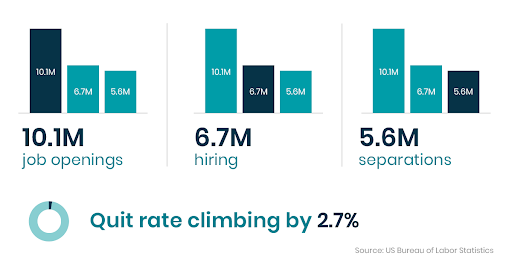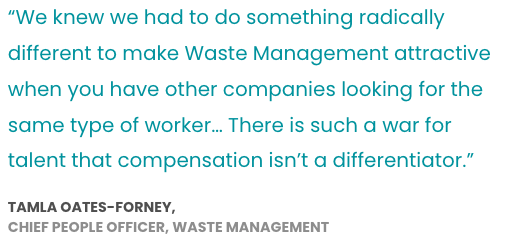Recently, a small gathering of (fully vaccinated) HR leaders from Fortune 1000 companies came together in Chicago. As they met, there was one topic they discussed that came up over and over: talent acquisition. The reasons are obvious — recent data concerning talent and the labor shortage shows a bleak outlook:

- According to a U.S. Bureau of Labor Statistics June report, there were 10.1 million job openings, with 6.7 million hires, 5.6 million separations and a quit rate that increased 2.7 percent.
- An August PwC survey reported that 88 percent of executives say their company is experiencing higher turnover than normal, and 65 percent of employees are looking for a new job.
- The U.S. Chamber of Commerce noted that there are “approximately half as many available workers (1.4) for every open job across the country as there have been on average over the past 20 years (2.8 historical average).” This ratio continues to fall.
Unfortunately, this situation cannot be alleviated quickly. The COVID-19 pandemic and its ongoing effects on the labor market have compounded the war for talent. On the campus recruiting front, freshmen enrollment plummeted an unprecedented 13 percent from fall 2019 to 2020, according to the National Student Clearinghouse. Things haven’t improved much since: In May, overall college enrollment decreased by 3.5 percent from spring 2020 to 2021. This drop is “seven times worse than the decline a year earlier, and the largest decline in year-over-year percent change and student headcount” in a decade. In short, the solution to your organization’s talent crunch is not coming from your campus recruiting program any time in the next three to five years.
Fortunately, one of the key solutions to the war for talent is talent development programs, of which the reasons are twofold: First, by shifting talent development programs into a recruiting tool, employers can attract better and more applicants. Second, turning talent development programs into a focused pipeline can address roles that are at high risk for talent shortages in the future.
Turning talent development into a brand asset

In the past month, talent development programs have been grabbing headlines in the national press: Waste Management, Walmart and Target all announced on national television that they are offering debt-free education programs. Other major employers, including Discover Financial and Chipotle, also announced significant expansions of similar programs.
After it’s launch of debt-free education programs in April, Waste Management kicked off a recruiting drive that attracted 1,200 people. This resulted in 420 offers and 70 percent of those people have started working for the company. More than half of those applicants mentioned the free college tuition offer.
Recently, Chipotle launched a national hiring campaign with 200 of its stores that were struggling to fill roles. The team reached out to more than 20,000 candidates in the first two weeks of the campaign. They received 7,500 applications for those 200 stores, which was a 46 percent increase in applications. Each store ended up hiring one to two new employees.

While much of this data revolves around education benefits, all these examples illustrate what PwC found in its report as one of the top five benefits employees want from their employers — expanded career development. Not only does this hold up as a reason to pick an employer, but also a reason to stay.
Turning talent development into a talent pipeline
While well-marketed development programs play a good short-term role in boosting both the number and quality of job applicants, it can positively impact a longer-term strategy too. With the right management and design, talent development programs can retain and upskill talent into areas that a company expects to have high talent demand in the future.
Employees actively engaged in talent development programs have a lower turnover. Prior to the pandemic, turnover rates in frontline industries such as manufacturing, retail trade and food services were about 30, 60 and 80 percent, respectively, according to the U.S. Bureau of Labor Statistics. These numbers are likely to climb in the coming year as we undergo what economists call “The Great Resignation.” As a point of comparison, Chipotle has cited a 90 percent retention rate for employees using its “Cultivate Me” benefits program, which represents a 42 percent increase in retention over a one-year timeframe.
But getting employees to stay with companies while they’re enrolled in programs to reduce the “leaky bucket” is not enough. Employers must turn their talent development programs into more intentional pathways for employees to climb the ranks. This includes workers of all types, not just those deemed as “high potential.”
Some employers are finding a correlation between those investing in long-term talent development programs, even in their frontline employees, with promotion rates two times their peers who aren’t a part of the programs. These companies are creating upskilling opportunities that are highly aligned to future of work jobs, like training in the skilled trades and digital technology. As a result, employees engaging in these programs are opening up more possibilities for their own economic mobility.
Fighting the war for talent on all fronts
No single system, process or tool will result in an organization winning the war for talent. This is an ongoing struggle that exists on multiple fronts, and it requires every team across various departments to devise a strategy. At the same time, it’s clear that a real substantive talent development program is now table stakes.
Without offering employees an opportunity to advance, there will be no way for the nation’s leading employers to attract the type of talent they need and want. Too much competition exists. With thoughtful programs and partners, as well as refined marketing and brand strategies, every organization can both find and develop amazing talent to position themselves for the future of work.















